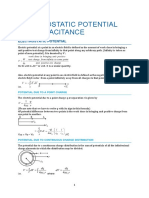0 ratings0% found this document useful (0 votes)
157 viewsEquipotential Surfaces and Electric Field Lines
Equipotential Surfaces and Electric Field Lines
Uploaded by
Jeison Jimenez AlvearThis document summarizes an experiment analyzing the relationship between electric field lines and equipotential surfaces. The experiment involved measuring electric potential at points near different electrode configurations and mapping equipotential lines and electric field lines. Key results were that electric field lines are perpendicular to equipotential surfaces and point away from higher potential regions. The experiment improved understanding of how electric field and potential are graphically represented and related based on fundamental properties like electric force and potential energy.
Copyright:
© All Rights Reserved
Available Formats
Download as PDF, TXT or read online from Scribd
Equipotential Surfaces and Electric Field Lines
Equipotential Surfaces and Electric Field Lines
Uploaded by
Jeison Jimenez Alvear0 ratings0% found this document useful (0 votes)
157 views5 pagesThis document summarizes an experiment analyzing the relationship between electric field lines and equipotential surfaces. The experiment involved measuring electric potential at points near different electrode configurations and mapping equipotential lines and electric field lines. Key results were that electric field lines are perpendicular to equipotential surfaces and point away from higher potential regions. The experiment improved understanding of how electric field and potential are graphically represented and related based on fundamental properties like electric force and potential energy.
Original Description:
Física Cuántica.
Original Title
Laboratorio_3
Copyright
© © All Rights Reserved
Available Formats
PDF, TXT or read online from Scribd
Share this document
Did you find this document useful?
Is this content inappropriate?
This document summarizes an experiment analyzing the relationship between electric field lines and equipotential surfaces. The experiment involved measuring electric potential at points near different electrode configurations and mapping equipotential lines and electric field lines. Key results were that electric field lines are perpendicular to equipotential surfaces and point away from higher potential regions. The experiment improved understanding of how electric field and potential are graphically represented and related based on fundamental properties like electric force and potential energy.
Copyright:
© All Rights Reserved
Available Formats
Download as PDF, TXT or read online from Scribd
Download as pdf or txt
0 ratings0% found this document useful (0 votes)
157 views5 pagesEquipotential Surfaces and Electric Field Lines
Equipotential Surfaces and Electric Field Lines
Uploaded by
Jeison Jimenez AlvearThis document summarizes an experiment analyzing the relationship between electric field lines and equipotential surfaces. The experiment involved measuring electric potential at points near different electrode configurations and mapping equipotential lines and electric field lines. Key results were that electric field lines are perpendicular to equipotential surfaces and point away from higher potential regions. The experiment improved understanding of how electric field and potential are graphically represented and related based on fundamental properties like electric force and potential energy.
Copyright:
© All Rights Reserved
Available Formats
Download as PDF, TXT or read online from Scribd
Download as pdf or txt
You are on page 1of 5
EQUIPOTENTIAL SURFACES AND ELECTRIC FIELD LINES
Gabriela Pardo˚ , Luisa López ˚ , Marı́a Fernanda Trocha ˚ , Marı́a José Mesa˚
˚ Engineering student. gabrielain2010@gmail.com
˚ Engineering student. luisadelcarmen.lopezsanchez@hotmail.com
˚ Engineering student. mafetroca08@gmail.com
˚ Engineering student. mariajosemesar@gmail.com
Resumen—The experience 3 has as its main objective to
analyze the characteristics or properties of electric field lines
and equipotential lines and thus, analyze and better understand
the existing relationship between the potential and the electric
field. In order to do this, some basic knowledge about the
meaning of the terms used will be used and points will be
found on the proposed assembly where the difference in potential
is approximately equal to the theoretical voltage of the given
negative electrode. These points with coordinates (x,y), are
recorded in a table that depends on the type of electrode: if
they are parallel, of equal and different sign or concentric. The
above, making use of a digital multimeter, an electrical source,
a probe, a coordinate system and the assembly described in the
guide. And it will allow the comprehension of concepts that, in
turn, will facilitate the study of the behavior of the field lines
with respect to the equipotential lines and make a sketch of the
electrode circuits that were previously mentioned.
Index Terms—electric potential, electric field, surface equipo- Electrode:An electrode is an electrical conductor used
tential field lines, equipotential lines. to make contact and pass current to a non-metallic part of
an electrical circuit, resulting in a job. In it oxide-reduction
functions occur.
I. T HEORETICAL F RAMEWORK Equipotential surfaces:In a region where there is an
electric field, the surfaces where the electric potential (V) has
the same value are called equipotential. That is, the potential
difference between two points on an equipotential surface is
The difference of Potential(Voltage): The difference of zero.
potential or voltage is the impulse that needs an electric The properties of equipotential surfaces can be summarized
charge so that it can flow through the conductor of an electric in:
circuit, this current will cease when both points equal their -The electric field lines are, at each point, perpendicular to the
electric potential. Its unit in the S.I. is volt (V) equipotential surfaces and go where the potential decreases.
-The work to move a load between two points of the same
Electric Potential: Or simply Potential, is the potential equipotential surface is null.
energy per unit load at any point (all points) of an electric -Two equipotential surfaces cannot be cut.
field. ( V = U/q ) [Serway]
Electric field lines:They are curved lines parallel to
the electric field vector existing at any point in space.
They are not material objects, they are used as a graphical
representation to have a qualitative description of the electric
field, just draw a finite number of lines starting from each
load. There are special cases, but in general, they do not
represent the trajectory of a charged particle moving in an
electric field Electric field lines help visualize electric fields.
Similarly, the potential at various points in an electric field
can be represented graphically by equipotential surfaces.
II. M ETHODOLOGY
-Set three voltage measurements at the D.C. output of the
supply panel for each of the electrode configurations.
-Establish a Cartesian coordinate system on the chart
paper by taking any point on the intersection of two lines.
These points must have the same or approximate potential
difference generated by the source and record their respective
coordinates in a table.
-Draw a continuous line through each set of points of equal
potential (equipotential lines) and label each line with its
respective potential.
-Perform the same process with all three electrode
configurations.
III. E XPERIMENTAL DATA
First assembly: Concentric electrodes
For the first assembly with concentric electrodes, the po-
tential differences with values of 7.86 ˘ 0.10V, 6.80˘0.004
V, and 4.230 ˘0.001V were sought, located in the following
points: Second assembly: Parallel electrodes
Third assembly: Point charge electrodes with different
signs.
In the second assembly of parallel electrodes the poten-
tial differences to look for were3.050˘0.009 V,4.090˘0.003
V,5.760˘0.001 V,and 7.280˘0.002V, located in the following
coordinates:
For the third assembly with electrodes with different point
charges, the potential differences with values of 5.740˘0.001
V,4.790˘0.001 V, and 6.3000˘0.0002 V were sought, located electric potential places where the potential decreases.
in the following points:
Analysis of the field at one point
-The direction of the vector of the field drawn on the point
is justified since, so much direction and sense of this in the
electric field in a point is given by the direction and sense of
the force that experiments a positive load in that point and if
the source load is positive the electric field will be a vector
directed outwards, opposite case if it was a negative load.
-For a point, no more than 2 lines of electric field must pass
through, since this is defined in each point of space, that is,
each point corresponds to a single field vector. If we assume
that 2 field lines intersect, they would have 2 tangent vectors
at the point where they intersect, that is, two field vectors for
the same point which is illogical.
V. C ONCLUSION
Once the experience of laboratory number three was
completed, a much more notorious relationship was
established between the electric field lines and the
equipotential lines, in addition, it was learned to correctly
graph both for different configurations of electrons. Since
the potential energy does not change as a test load is moved
over an equipotential surface, the electric field does not work
on that load. From the above, it follows that it must be
perpendicular to the surface at each point so that the electrical
force is always perpendicular to the displacement of a load
moving over the surface.
IV. DATA A NALYSIS
Analysis of the lines During the development of this practice, we understood
The criterion used to draw the electric field lines was to take with greater clarity the concept of equipotential lines, these
previously acquired knowledge in class about electric field being the graphical representation of equipotential surfaces,
and electric field lines. which are three-dimensional surfaces with the same electrical
To draw the electric field lines the following rules are potential value.
followed by agreement:
- Taking into account that near a positive charge, another -Regardless of the electron arrangement, low voltage
positive charge is repelled, then it is deduced that the electric equipotential zones are established around the negative
field force lines çome out.of the positive charges, while they electrode zone; as we approach the positive electrode, the
”dieı̈n the negative ones. voltages begin to increase until they are almost the voltage of
- It is known that the lines of force reach negative charges. the source.
- In order to maintain a homogeneous criterion, a number
of lines of force proportional to the value of the load were -Equipotential lines tend to be the same shape as rod
drawn. electrodes, equipotential lines tend to be parallel to it. For
- The lines of force were drawn symmetrically around the a circle or dot electrodes, lines tend to be concentric with a
loads. larger radius.
- The lines of force cannot be cut because otherwise, at
the point of intersection, the force experienced by a load -At any point on an equipotential surface, the field vector
located there would have two possible directions, which is is perpendicular to it.
not possible.
-With this laboratory, we were able to put into practice the
The direction of the electric field lines is justified since their use of devices such as the digital multimeter, however with
representation is two-dimensional, therefore the field lines the materials supplied in this laboratory we were able to put
can be said to range from positive to negative charges. It into practice the concept of equipotential surfaces as they are
can also be said that the direction of the electric field lines not visible but are known to exist.
is directed from the place with the highest concentration of
VI. R EFERENCES
Sears, F. W., Zemansky, M. W., Young, H. D., Vara, R.
H., Garcı́a, M. G., Gümes, E. R., ... Benites, F. G. (1986).
Fı́sica universitaria (No. 530.076 530.076 S4F5 1986 S43F5
1986 QC23 S45 1986). Fondo Educativo Interamericano.
Serway, R. A., Jewett, J. W., Hernández, A. E. G., López,
E. F. (2002). Fı́sica para ciencias e ingenierı́a (No. 530 530
S4F5 2002 S47F5 2002). McGraw-Hill.
C. Ángel, J. Castelblanco, H. Gómez, J. Herrera, O. Torres.
Lı́neas equipotenciales [online] [Citado Marzo de 2016]:
https://electromagnetismo2011b.wikispaces.com/file/view/Informe+
de+laboratorio+LINEAS+EQUIPOTENCIALES.pdf
Martı́n, Teresa. Campo eléctrico. Lı́neas
eléctricas [online] [Citado Marzo de 2016]:
http://acer.forestales.upm.es/basicas/udfisica/asignaturas/fisic
a/electro/campoelectr.html
You might also like
- Lab Report: Faculty of Science & Mathematics Universiti Pendidikan Sultan IdrisDocument6 pagesLab Report: Faculty of Science & Mathematics Universiti Pendidikan Sultan IdrisNisha Lauren VishvanathNo ratings yet
- Lab2 Det10013Document6 pagesLab2 Det10013FirdausNo ratings yet
- PHY094 Past Years QuestionDocument7 pagesPHY094 Past Years QuestionShafiqah IsmailNo ratings yet
- Physics Lab ReportDocument3 pagesPhysics Lab ReportSharon Tai67% (6)
- Light Intensity LabDocument4 pagesLight Intensity LabNkindé Ambalo100% (1)
- Exp5 T10 Group 4Document9 pagesExp5 T10 Group 4NaimzNaimNo ratings yet
- Code of Ethics & Proffesional Conduct PDFDocument21 pagesCode of Ethics & Proffesional Conduct PDFIr Ahmad Afiq100% (1)
- Son, K. H. and K. Nomoto (1982) PDFDocument9 pagesSon, K. H. and K. Nomoto (1982) PDFl.andrei08No ratings yet
- 9.design of JIB Crane Supporting StructuresDocument14 pages9.design of JIB Crane Supporting Structuresepe civilNo ratings yet
- University Physics Lab Report (UWI)Document10 pagesUniversity Physics Lab Report (UWI)VanoiMariaStylesWilkinson100% (1)
- Shivaani Vidhyaa Mandir School Aranthangi: Force On A Current Carrying Conductor in A Magnetic FieldDocument11 pagesShivaani Vidhyaa Mandir School Aranthangi: Force On A Current Carrying Conductor in A Magnetic FieldMohamed Ashraf MANo ratings yet
- Complex Ion of Nickel (II) ChlorideDocument5 pagesComplex Ion of Nickel (II) Chloridebasikal petakNo ratings yet
- Test 1 - Set 1 - PHY150Document4 pagesTest 1 - Set 1 - PHY150liliNo ratings yet
- Phy150 Laboratory Report Experiment 4Document12 pagesPhy150 Laboratory Report Experiment 4Nurul Adira FaziraNo ratings yet
- Phy098 Problem Solving AssignmentDocument12 pagesPhy098 Problem Solving AssignmentMUHAMMAD FIKRI BATHURUL ZAMAN SHAHNo ratings yet
- Exp 3Document8 pagesExp 3ValentinoDullSatinNo ratings yet
- Physics Viva Cbse PracDocument2 pagesPhysics Viva Cbse PracNikhil JhaNo ratings yet
- SPM 4531 2005 Physics p1 BerjwpDocument15 pagesSPM 4531 2005 Physics p1 Berjwppss smk selandarNo ratings yet
- Series Parallel Lab ReportDocument3 pagesSeries Parallel Lab ReportMitch Gramazio20% (5)
- Lab Report 2 Phy547: Experiment 2: Zener Diode and Power SupplyDocument8 pagesLab Report 2 Phy547: Experiment 2: Zener Diode and Power SupplyAtikah IzzatiNo ratings yet
- Lab3group11 PDFDocument13 pagesLab3group11 PDFdharwinNo ratings yet
- EXPERIMENT 6 Dissimilarity Between LECTROVALENT AND COVALENT BONDDocument7 pagesEXPERIMENT 6 Dissimilarity Between LECTROVALENT AND COVALENT BONDMuhamad Faris88% (8)
- 2 Report ExampleDocument2 pages2 Report ExampleEngku AzrimNo ratings yet
- Report On Musical Bell On BreadboardDocument8 pagesReport On Musical Bell On BreadboardSoham RautNo ratings yet
- Chapter 5Document13 pagesChapter 5aregawi weleabezgi100% (1)
- Lab 2 Fluid Bernoulli's Theorem DemonstrationDocument8 pagesLab 2 Fluid Bernoulli's Theorem DemonstrationNURUL AINA BINTI MOHAMAD FUAD STUDENTNo ratings yet
- Latihan SkoDocument17 pagesLatihan Skorusnah chungNo ratings yet
- PHY150 Lab Report 3Document2 pagesPHY150 Lab Report 3Sal Sabeela RahmanNo ratings yet
- Det1022 PW3Document9 pagesDet1022 PW3Muhammad FaissalNo ratings yet
- Phy 210Document2 pagesPhy 210nadiaNo ratings yet
- Practical 4Document7 pagesPractical 4Penjejak AwanNo ratings yet
- Kohlberg's Moral Reasoning: Stages of Moral DevelopmentDocument15 pagesKohlberg's Moral Reasoning: Stages of Moral Developmentaashir khanNo ratings yet
- SKL 1013 (Laboratory Report 1)Document12 pagesSKL 1013 (Laboratory Report 1)Raajeshwary.T100% (1)
- Laboratory ReportDocument9 pagesLaboratory ReportXuan ChuaNo ratings yet
- LAb - 02 - Voltage and Current Divider RuleDocument6 pagesLAb - 02 - Voltage and Current Divider RulemakoNo ratings yet
- SolutionChap32 PDFDocument25 pagesSolutionChap32 PDFChai Usajai Usajai100% (1)
- Ohm's Law Peka 4pd3Document2 pagesOhm's Law Peka 4pd3lilysuhany100% (4)
- Tutorial Chapter 6Document3 pagesTutorial Chapter 6malzNo ratings yet
- Ohm's Law Lab ReportDocument7 pagesOhm's Law Lab ReportIzzah hazziqa100% (1)
- LAB 1 DET10013 (Online)Document14 pagesLAB 1 DET10013 (Online)Azim NawawiNo ratings yet
- F5 ExperimentsDocument27 pagesF5 ExperimentsNarend Gunner80% (5)
- Chapter 2 - Carrier Transport PhenomenaDocument54 pagesChapter 2 - Carrier Transport PhenomenaDesmond Kuek100% (2)
- Industrial Training ReportDocument34 pagesIndustrial Training ReportDeeeelaaaaNo ratings yet
- BERE1013 Lab 5 - Snell's Law 1.0Document10 pagesBERE1013 Lab 5 - Snell's Law 1.0Aina BalqisNo ratings yet
- Experiment 10 Glass Blowing 10.1 Objectives: SKU3073 Chemistry Semester 1 2020/2021Document12 pagesExperiment 10 Glass Blowing 10.1 Objectives: SKU3073 Chemistry Semester 1 2020/2021Maldini Josnon100% (1)
- ConclusionDocument1 pageConclusionzul100% (1)
- Etn104 - Principles of Electrical EngineeringDocument10 pagesEtn104 - Principles of Electrical Engineeringg-49214873No ratings yet
- Result Simulation 2 PHY340Document4 pagesResult Simulation 2 PHY340Nur Izzatul AnisNo ratings yet
- Electrochemistry and Corrosion Science: Laboratory ReportDocument7 pagesElectrochemistry and Corrosion Science: Laboratory Reportacap100% (6)
- Lab Report CapacitanceDocument13 pagesLab Report CapacitanceQhairunnissaNo ratings yet
- Lesson Plan: Mohdruza@uitm - Edu.myDocument3 pagesLesson Plan: Mohdruza@uitm - Edu.myEronecca Benidict100% (1)
- Equipotential Lines Final ReportDocument11 pagesEquipotential Lines Final ReportOmar HusseinNo ratings yet
- LAB 4 - Potencial y Campo ElectricoDocument6 pagesLAB 4 - Potencial y Campo ElectricoAlvaro Heredia GilNo ratings yet
- Electric Field LinesDocument20 pagesElectric Field LineslostgirlNo ratings yet
- Equipotential Lines-1Document3 pagesEquipotential Lines-1hassantamer2005a1No ratings yet
- Stem 2 Lab Experiment 3 VIRTUAL - Potential and Equipotential Lines v4Document13 pagesStem 2 Lab Experiment 3 VIRTUAL - Potential and Equipotential Lines v4faisal alkamaliNo ratings yet
- Module 3-CAPACITANCEDocument14 pagesModule 3-CAPACITANCEkylie jonesNo ratings yet
- Electric Field and Potential Lab ReportDocument6 pagesElectric Field and Potential Lab ReportAudio books LibraryNo ratings yet
- Electric Fields & CapacitorsDocument19 pagesElectric Fields & CapacitorsMohsen SaidiNo ratings yet
- Electrostatic Potential and CapacitanceDocument19 pagesElectrostatic Potential and CapacitanceNancy SinghNo ratings yet
- Chapter 17 - Electric Field 2017Document54 pagesChapter 17 - Electric Field 2017gabriel phoonNo ratings yet
- NameDocument4 pagesNamemira.120230131No ratings yet
- Biomekanika S1Document11 pagesBiomekanika S1Muthiah Hasnah SuriNo ratings yet
- Mechanics Lab Report FileDocument5 pagesMechanics Lab Report FileDanish WazirNo ratings yet
- EXP 4 Determination of Orifice ConstantsDocument6 pagesEXP 4 Determination of Orifice Constantssiva ramNo ratings yet
- Patankar SV 1967 PHD ThesisDocument222 pagesPatankar SV 1967 PHD ThesisJ MrNo ratings yet
- Chapter 11Document16 pagesChapter 11wsv6xpqphfNo ratings yet
- Chapter IIDocument11 pagesChapter IIShayn ShaynNo ratings yet
- 356.0-T6 Permanent Mold Cast (SS)Document10 pages356.0-T6 Permanent Mold Cast (SS)farshadbakhtiari79No ratings yet
- Mechanics of Additive and Advanced Manufacturing PDFDocument105 pagesMechanics of Additive and Advanced Manufacturing PDFwhatsupbinodNo ratings yet
- Exp 10Document2 pagesExp 10breathcontrollerNo ratings yet
- Lagrangian Modeling of DC-DC Buck-Boost and Flyback ConvertersDocument4 pagesLagrangian Modeling of DC-DC Buck-Boost and Flyback ConvertershalpaslanNo ratings yet
- Appendix A Example 2 - Type I Bearing (Steel Reinforced) Method ADocument6 pagesAppendix A Example 2 - Type I Bearing (Steel Reinforced) Method AJose ManzanarezNo ratings yet
- Turbine Meter Calculation FundamentalDocument10 pagesTurbine Meter Calculation FundamentalMuhammad Sa'adNo ratings yet
- Inertial MEMS Principles and Practice 1st Edition Volker Kempe 2024 scribd downloadDocument50 pagesInertial MEMS Principles and Practice 1st Edition Volker Kempe 2024 scribd downloadrafusmiers1w100% (4)
- Problem 1.4Document3 pagesProblem 1.4abc xyzNo ratings yet
- Derivation of Circular Motion Physics Using Calculus: Brandon A. BelnaDocument5 pagesDerivation of Circular Motion Physics Using Calculus: Brandon A. BelnaBrandoneNo ratings yet
- DPP - 01 - Work Power EnergyDocument3 pagesDPP - 01 - Work Power Energyaayushmishra13aa57No ratings yet
- Effectiveness and Efficiency Analysis of Parallel Flow and Counter Flow Heat ExchangersDocument6 pagesEffectiveness and Efficiency Analysis of Parallel Flow and Counter Flow Heat ExchangersInternational Journal of Application or Innovation in Engineering & ManagementNo ratings yet
- Week 2 Material and MANUFACTURINGDocument68 pagesWeek 2 Material and MANUFACTURINGضياء بن احمد الكباريNo ratings yet
- Heat ChemCADDocument25 pagesHeat ChemCADthawdarNo ratings yet
- Major and Minor Losses in PipesDocument15 pagesMajor and Minor Losses in Pipesanjalid9176% (17)
- Installation of Groups of Stone Columns in ClayDocument10 pagesInstallation of Groups of Stone Columns in ClayNasroden PagayaoNo ratings yet
- 2015 Reith Lecture Hawking Ep1Document7 pages2015 Reith Lecture Hawking Ep1gorda1997100% (1)
- WORK and EnergyDocument7 pagesWORK and EnergyLeonard NdlovuNo ratings yet
- Application Solutions of Plane Elasticity: Professor M. H. SaddDocument22 pagesApplication Solutions of Plane Elasticity: Professor M. H. Saddbereket gNo ratings yet
- Notes of Velocity Triangle With ProblemsDocument23 pagesNotes of Velocity Triangle With Problemsjoseph prasanna kumar67% (3)
- Friction Gravity and Elastic Forces Power PoinDocument60 pagesFriction Gravity and Elastic Forces Power PoinMurniNo ratings yet
- Engineering Mechanics AME1103Document4 pagesEngineering Mechanics AME1103Ravi Kiran GotetiNo ratings yet
























































































